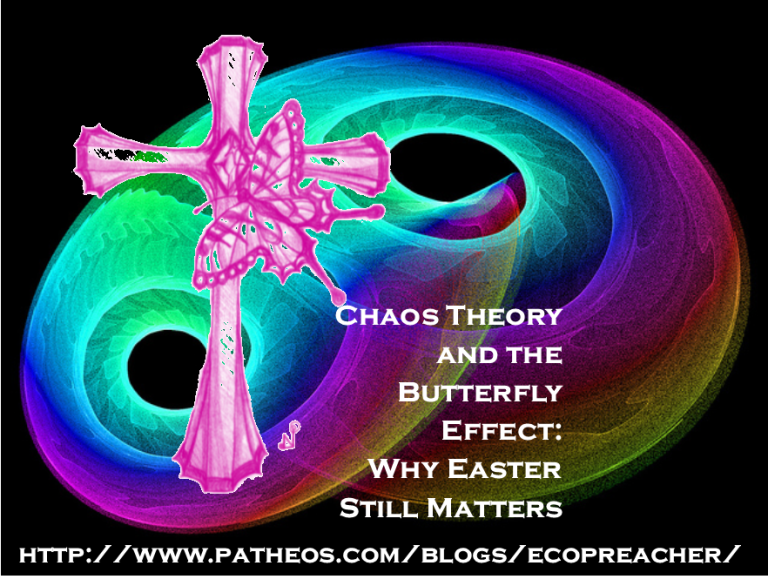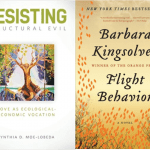This may be a difficult year for Christians to proclaim the Good News of the resurrection of Jesus Christ on Easter Sunday.
Especially when Syrian massacres are escalating.
And the mother-of-all-bombs and Tomahawk missiles mean military conflict in the Middle East is escalating.
And pro- and anti-Trump clashes are escalating.
And North Korean military demonstrations are escalating.
And climate change feedback loops are escalating.

The Easter Conundrum
So Progressive Christians are caught in a difficult place. Sermons preaching Jesus’ glorious resurrection can sometimes feel disingenuous. The ubiquitous butterfly-and-cross images can feel trite. The old personal atonement themes of Jesus-dying-for-my-sins can feel as hollow as the chocolate bunnies in the basket – with about the same level of nutritional value. And the escalation of global conflict and possible nuclear war – all while planetary ecological conditions rapidly deteriorate – leave us wondering if the Easter story is even relevant anymore?
Yet the power of the Resurrection stands its ground in front of us. It will not let us off that easily. Ours is not the first generation to face existential annihilation. So is there a way to proclaim the resurrection that is at once authentic, honest and hopeful – without succumbing to the temptation of giving false hope and cheap grace? Is there a way to reclaim the Easter butterfly? Especially when butterflies like the monarch are one of the most threatened species on the planet?
Chaos theory?
Chaos theory is one possible way of recasting the resurrection narrative with a fresh perspective informed by science that may offer some surprising insights for Christians.
Chaos theory originated in the field of mathematics as a study of the way in which initial conditions affect dynamic systems. Sometimes called “the butterfly effect,” chaos theory studies the way non-linear reactions happen in supposedly stable systems. The phrase was coined by meteorologist Edward Norton in the 1960s when he described the flapping of a butterfly’s wings in one part of the world potentially creating a hurricane somewhere else on the planet. If you’ve read Ray Bradbury’s 1950s short story “A Sound of Thunder,” where the death of a butterfly in one moment in time has unexpected ramifications thousands of years later – this is chaos theory.
What’s so refreshing about chaos theory when applied to hegemonic human structures is its ability to break open any hubristic idea that we can control (benevolently or otherwise) nature and, by extension, our fellow humans. Personified in mythology by the “trickster” figure, chaos theory shows up in characters like Br’er Rabbit in African folklore, the Coyote figure in Native American mythology, and even Bugs Bunny from Saturday morning cartoons. They are the court jesters – the “holy fools” – who tell the truth through humor, wit and cunning. “It is not simply that fools change our perspective, though they do that. Rather, fools create a liminal space where new perception becomes possible, but where discernment is both invited and required,” (Campbell and Cilliers, 87).
Jesus the Trickster!
Homileticians Johann Cilliers and Charles Campbell identify Jesus as the ultimate liminal figure. So Jesus is a trickster! “[C]rossing boundaries, teaching and preaching with intentional ambiguity, and calling people to perceive and live at the threshold of the old age and the new – in the reign of God that is breaking into the world. . . [Jesus embodies] in his own person the threshold between the human and the divine, between the old age and the new,” (Campbell and Cilliers, 103).
From an ecological perspective, I’ve always been fascinated with the way in which Jesus, in his role as Trickster, enlists the elements of nature and his non-human kin to “play.” Wind and wave obey his command (Matthew 8:24-27, Mark 4:35-41, Luke 8:22-25). Birds and flowers serve as his teaching partners (Luke 12:24-32), as do fig trees (Matthew 24:32-35, Mark 13:28-31, Luke 21:29-33), wind and weather (Matthew 5:44-45, Luke 12:54-56, John 3:8). Water sneakily becomes wine in stone jars at the Cana wedding (John 2:1-11), and holds him up when he walks across the sea (Mark 6:48-51, John 6:18-21). Stones are enabled to cry out in praise (Luke 19:40). In all these cases, Creation surprises and even suspends its “natural” processes for the sake of thwarting our expectations.
Even the miraculous conception of Jesus in the womb of the Virgin Mary, normally problematic for most feminists, could be seen differently through the trickster lens. Rather than interpreting Jesus’ conception (devoid of sexual intercourse) as proof that sexuality – and thus women – are “dirty” and “sinful,” it may be that Jesus’ surprising conception is meant as a trick played on patriarchy that tries to control and dictate the activity of procreation, often victimizing the women in the process. In the case of Jesus’ conception – surprise! – men are taken completely out of the procreative picture. Which opens up new possibilities for women’s liberation, agency, and power.
The Trickster-Surprise of the Resurrection
And then we come to the Resurrection story. Now we see that Trickster-Jesus has played the ultimate joke on the forces of evil that would subjugate, humiliate and annihilate God’s life-giving love. This means the preacher-fool can joyfully proclaim the surprise of God’s grace upending the structures of death and revealing the triumph of resurrection.
Campbell and Cilliers remind us that “Christ carries in his resurrected body the coarse and vulgar joke of crucifixion. The joke, one might say, lives on. . . .[T]hrough the resurrection Christ defeats the final enemy – death – and sets believers free from the fear of death so we might take up the foolish way of the cross,” (34, 35). Like his crucifixion, Jesus’ resurrection “interrupts the world’s assumptions, opens a liminal space, and calls for new perception – for the bifocal vision at the juncture of the ages,” (36).
With this bi-focal vision applied to chaos theory, we are reminded us that “during stressful periods, particular changes at the micro-level of a given system can generate macro-level changes involving a massive phase shift. In other words, local perturbations can trigger off global changes,” (Zimmerman, 324).
Put another way:
a protest at a town hall meeting against injustice,
or an act of kindness extended to one’s sworn enemy,
or the closing of a coal plant,
or a refusal to return violence with more violence,
may set off shifts in social, economic and ecological dynamics that are not discernible at the outset, but have wider-ranging effects than initially realized.
Ecofeminist theologian Sallie McFague puts it best: “We must believe . . . that life, not death, is the last word; that against all evidence to the contrary (and most evidence is to the contrary), all our efforts on behalf of the well-being of our planet and especially of its most vulnerable creatures, including human ones, will not be defeated. It is the belief that the source and power of the universe is on the side of life and its fulfillment. The ‘risen Christ’ is the Christian way of speaking of this faith and hope: Christ is the firstborn of the new creation, to be followed by the rest of creation, including the last and the least,” (McFague, 191).

What good are a butterflies wings against the hurricane?
Of course, as we partake in the rituals of Easter, some will still accuse us of being fools. An altar with candles is nothing against the explosions of sarin bombs. Easter lilies against MOABs are laughable. Peaceful protesters are nothing against the powers of the militarized police. What difference does it make? You accomplish nothing. You are fools.
Further, Jesus’ light is nothing against the darkness of evil. What good are a butterflies wings against the hurricane? So what if he was resurrected – what difference did it make? Hunger, poverty, disease, injustice, climate change, violence, war and death – those powers are still the law of the land.
And this is a fact. But do not underestimate the power of the Trickster-Jesus and the disrupting chaos of the cross. People advocating for the monarch butterfly and planting milkweed seeds and calling for the end of herbicides are all creating a small but noticeable increase in the population of the orange-winged insects. Micro-level changes are disrupting macro-level devastations.
In the same way, Christians singing hymns of joy, using a few drops of water for baptism, eating little crusts of bread and sipping tiny cups of wine, being generous and offering compassion to our neighbors, actively taking part in resistance to oppression, spontaneously erupting with the Easter laugh . . . these are micro-level disruptions of macro-level evil. And they sustain us, even surprise us, with God’s grace. The wind from the butterflies wings are the hurricane! The hurricane against the systems of oppression and injustice that had assumed eternal reign.
So go ahead and laugh and live. Because we know something that they don’t know. We may be living in the long night of Good Friday, but the promise of God’s Easter Sunday morning is sure to surprise us with joy. And the Trickster Jesus will always have the last laugh.
For another post on the “butterfly effect” as it relates to ecological and economic justice, click here.
For a reflection about preaching on Earth Sunday, click here.
Leah D. Schade is the Assistant Professor of Preaching and Worship at Lexington Theological Seminary (Kentucky) and author of the book Creation-CrisisPreaching: Ecology, Theology, and the Pulpit (Chalice Press, 2015).
You can follow Leah on Twitter at @LeahSchade, and on Facebook at https://www.facebook.com/LeahDSchade/.
Sources:
Charles L Campbell. and Johan H. Cilliers. Preaching Fools: The Gospel as a Rhetoric of Folly. Waco, TX: Baylor University Press, 2012.
Sallie McFague. The Body of God: An Ecological Theology. Minneapolis: Fortress Press, 1993.
Michael E. Zimmerman. Contesting Earth’s Future: Radical Ecology and Postmodernity. Berkeley: University of California Press, 1994.

















